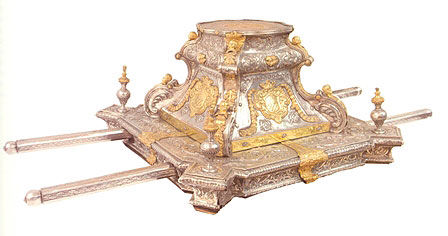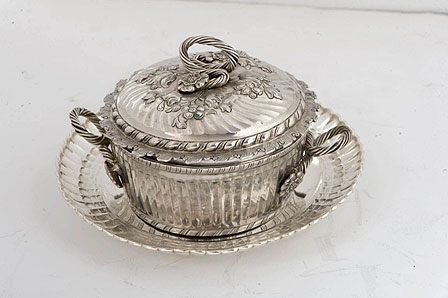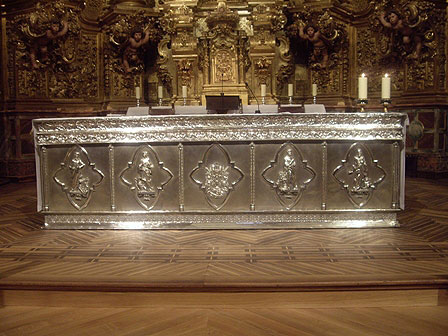BRINGING HERITAGE CLOSER. CORELLA
25 August 2010
The sumptuary arts: at the service of the splendor of Worship and Liturgy
D. Ignacio Miguéliz Valcarlos. Chair of Heritage and Art of Navarre.
In the churches of Corella there is a rich collection of works belonging to the so-called Artes Sumptuarias, made up of silver jewelry and ornaments. These pieces arrived to these temples between the XVI and XX centuries, sometimes acquired by the churches themselves, and in others coming from gifts made by native sons of Corella who wanted to honor their native invocations.
The most numerous group is the works of silverware, which constitutes a singular and unique set, with pieces from both Navarrese and foreign workshops, Hispanic and American. issue This collection covers a wide range of typologies, and although there are pieces from the 16th century, such as the figures of the Virgin and Saint John from a processional cross, or the two identical navetas from the churches of El Rosario and San Miguel, and from the 19th century, There is no doubt that the most numerous and important set, both for the richness of the pieces, and above all for their quality, is the one made during the baroque centuries, a time when Corella reached its maximum splendor. Some of these pieces are unique in Navarre, as is the case of the Guatemalan dulcera of the church of the Rosary, a piece of civil character of great rarity, or the processional platforms, belonging to both parishes. The latter was a gift from Roque Aguado in 1766, and due to its weight had to be remade in Pamplona by the silversmith Miguel de Lenzano in 1777. With the silver left over from the new platforms, the silversmith collected his work and also made two sets of sacral vestments for the churches of Rosario and San Miguel. Also to the munificence of Roque and his brother Antonio the church of the Rosary owes a magnificent monstrance richly carved by the silversmith Juan Antonio Pastor in 1756 in silver in its color and gilded silver with overlays of emeralds.
But the aforementioned sets of sacras are not the only works that are repeated in both parishes, since in Corella we find the singularity that the two churches were of board of trustees municipal, so he commissioned identical silver works for both temples, as we can see not only in these sacras, but also in the aforementioned Mannerist navetas, in a set of crosses and Baroque candlesticks from Madrid, or in some lecterns carved in Calahorra. And along with the above, other pieces of singular relevance are the choir monstrance from Sicily given by Don José Bruno de Luna y sesma, knight of the Order of Malta, formerly in the church of the Rosary and currently in the Arrese Museum, or the gilded silver chalice of the Carmelites of Araceli, one of the first works to arrive in Navarre from the Americas.
As for the set of ornaments preserved in the temples of Corella, we can highlight the terno de las calaveras, embroidered in 1580 for the church of San Miguel, the one of the Aguado family, from Genoese workshops, given by the Aguado brothers in 1762, or the one of Toledo, coming from this town and made in the second half of the 18th century.And finally we cannot forget the mantles of the Virgin of Araceli, such as those given by the queens Bárbara de Braganza or Isabel II, or by the García de Loigorri family.

Andas. Pamplona. Miguel de Lenzano. 1777. Corella. Churches of San Miguel and the Rosary.

Sweet. XVIII CENTURY. Second half. Guatemala. Corella. Church of the Rosary

Altar frontal. S.XIX. 1881. Meneses. Madrid. Corella. Church of San Miguel
PROGRAM
Tuesday, 24th August
Milestones in the History of Corella
D. Esteban Orta Rubio. Society of Historical Studies of Navarre
Writers and publicists of Baroque Corella
Mr. Javier Itúrbide Díaz. Uned of Tudela
Corella in the culture and art of the Baroque period
D. Ricardo Fernández Gracia. Chair of Heritage and Art of Navarre
Wednesday, 25th August
The hidden Corella. Behind the lattices of the city's enclosures
D. Ricardo Fernández Gracia. Chair of Navarrese Heritage and Art
The sumptuary arts: at the service of the splendour of worship and the Liturgy
D. Ignacio Miguéliz Valcarlos. Chair of Navarrese Heritage and Art
The festive calendar
D. Francisco J. Alfaro Pérez. University of Zaragoza
visit to the church of San Miguel
visit to the tunnels
Thursday, 26th August
A look at architecture and the arts in Corella in the 19th and 20th centuries
José Javier Azanza López. Chair of Navarrese Heritage and Art
The image of the Rosary and Saint Michael in the arts
Ms. Mª Gabriela Torres Olleta. GRISO. University of Navarra
Corella, conventual and palatial city: visit guided tour
Ms. Pilar Andueza Unanua. Chair of Navarrese Heritage and Art
Closing

